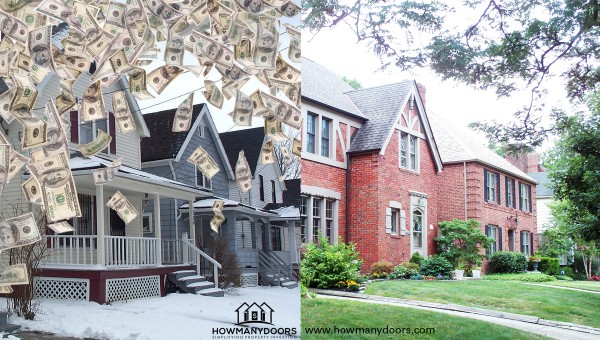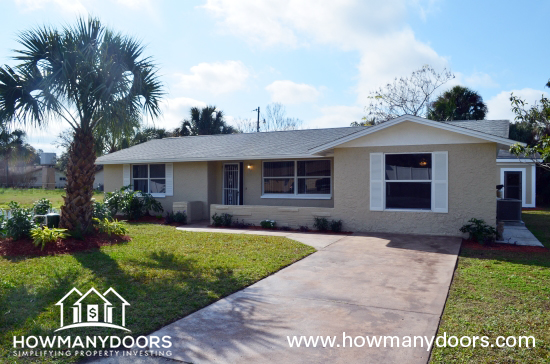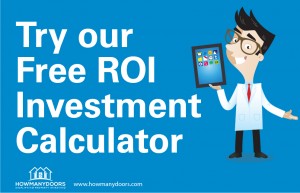Cash Flow Real Estate Is The New Black
Maybe you’ve noticed the trend, too, that folks with advice on investing in real estate are saying things like “Cash flow is king,” and “It’s not ‘Location. Location. Location.’ - it’s cash flow.” Period.

Caption: Cash flow real estate is what smart investors should look for, retaining a local turnkey property management company to make it easier. Check out the cash flow real estate rentals available on HowManyDoors.
While many real estate investing principles are evergreen, these days, the focus is on staying “in the black,” not investing to wait for property to appreciate in value for resale, but to invest in a rental property for immediate return. Cash flow from your real estate investment is the new black.
So where do we start to evaluate the cash flow potential of your real estate investment options? We start with the market price point of the rental property and local rental rates. Nationwide, there are more than 43 million renting households and nearly 104 million residents occupying those households (check out our US Real Estate Market Investor Outlook report). That’s about a third of our population and the rate is growing - another positive trend for the real estate investor. However, not all of these households represent good cash flow real estate opportunities.
The Rent to Price Ratio: The rent to price ratio is a simple place to start, and helps you narrow down your options to the choices that offer the best potential for driving cash flow. Using the rent to price ratio will reveal whether a rental property can provide a decent return on investment, yet doesn’t require you to dig into all the property-specific expense data. It’s an industry benchmark calculation, sort of a “rule of thumb,” which estimates the number of years it would take to pay off the price paid for the property with only the gross rent received (not net of any expenses, such as property taxes, insurance, maintenance, etc.). This rent-to-price ratio is referred to as the Gross Rent Multiplier (GRM) and you calculate it as the price of a real estate property purchase divided by the annual rental income. As an investor, you want to see a lower GRM (roughly 15 or less), not a higher GRM (20 or more) - the higher the number, the less potential for positive cash flow.
Let’s do the Math: Here’s how you calculate the Gross Rent Multiplier (GRM) based on the market value of a recent real estate property sale price, divided by the annual gross rental income.
Calculation: Market Value / Annual Gross Rental Income = GRM
Example: Property sold for $250,000 / $20,000 Annual Income = 12.5 GRM
So, in the above example, it would take nearly 13 years to pay off the sale price of the rental property with only the gross annual cash flow from renting the property.
The GRM is particularly useful when you’re selecting and comparing locations for cash flow real estate investments, because it helps you make a rough comparison, assuming expenses might be fairly uniform in both areas. However, don't take the calculation too far. It’s real value is in helping you narrow down your list of potential locations. It’s once you’ve narrowed your focus that you’ll do a deep dive into the details to measure the return, and cash flow, and the cap rate, with consideration for all the expenses you’re likely to incur when you purchase rental real estate.
For a strong investment option in cash flow real estate, make sure you buy in neighborhoods that offer:
- Favorable rent to price ratios
- Stable employment base
- High percentage of owner-occupied homes
- Good local turnkey property resources and management teams
Where’s the best place to find favorable rent to price ratios?
You’ll find pockets in many states, but some of the better options today are in Florida, New York, Indianapolis, and Ohio. No matter where you look, our guide, 10 Tips to Select a Location, walks you through the logic of the above criteria. And check out these turnkey cash flow real estate listings to see a sampling of real prices and the potential returns for today’s market conditions.
Build your cash flow profile:
Don’t over-think it or over-analyze, just do some detective work, such as following redevelopment and infrastructure spending reports, and looking for large company headquarters and colleges or universities. For our turnkey properties, we provide market summary reports on the specific area and include easy to read graphs, charts and recommendations. Here’s an extract of the bottom line profile for an example cash flow real estate property in Indianapolis:
Sample Market Summary:
Indianapolis is strong for cash flow real estate investments
"Indianapolis has a growing population sustained by a diversified and expanding economy fueled by health care, education, entertainment and manufacturing. The downtown is slowly but consistently evolving and the region is well known as an affordable place to live and regularly named in numerous “best cities to live in” lists. The metro region has a very low unemployment rate at 5% and favorable rental to home price ratios due to the remarkably low acquisition price for residential real estate. This creates high cap rates of over 10% and cash-on-cash returns of 20%+ making it a solid income-producing region. The region has potential for some reasonable, low single-digit appreciation. It’s a strong cash-flow real estate market.
3 Steps to buying your first cash flow real estate:
We’re skipping over some of the finer points here, but you’ll get the drift - and you can access the details, starting with our Real Estate Basics, which cover these three basics steps:
Educate yourself: Cash flow real estate investing is like any skill and can be learned. Begin with the basics of real estate, then move on, step by step, to advanced topics such as Making It Happen.
Be prepared to invest out of state: Every situation is different, but in many cases, your local market just won’t provide the right opportunities. So prepare yourself, and download our FREE Mini-Guide To Buying Out Of State Properties to understand the economics of here vs there, the pros and cons, and tips for managing a remote investment.
Identify your team: “It takes a village” is something you should keep in mind as you select your turnkey team. Find real investors who both own and manage rental properties, and leverage their access to licensed contractors, and experienced property management companies to make your cash flow real estate investment a success.
Could cash flow real estate be “the new black” for you? Check out these cash flow real estate listings.
Take a Virtual Tour
of a Turnkey
Investment Property
Properties like this single-family home have been renovated, independently inspected, are professionally managed and already produce cash flow - a great option for beginners (and pros!) who want to get into real estate investing.
We’re not in
Kansas anymore!
Sometimes the best investment opportunities are in another state. Don’t let that stop you - just bone up on the ins and outs of buying turnkey properties out of state. - Start Now
FREE Tool: Return on Investment Calculator
A great tool for beginners and pros alike who want to know how to invest in real estate. Forecast your cash flow with just an address - try it now



